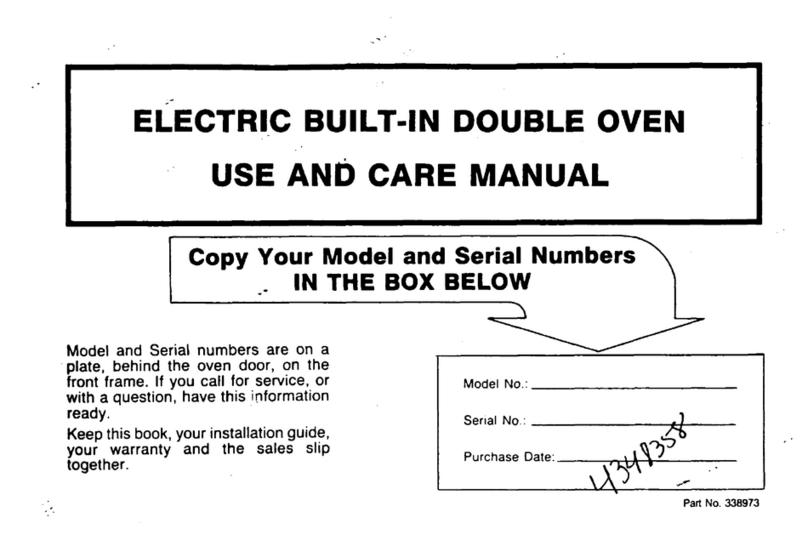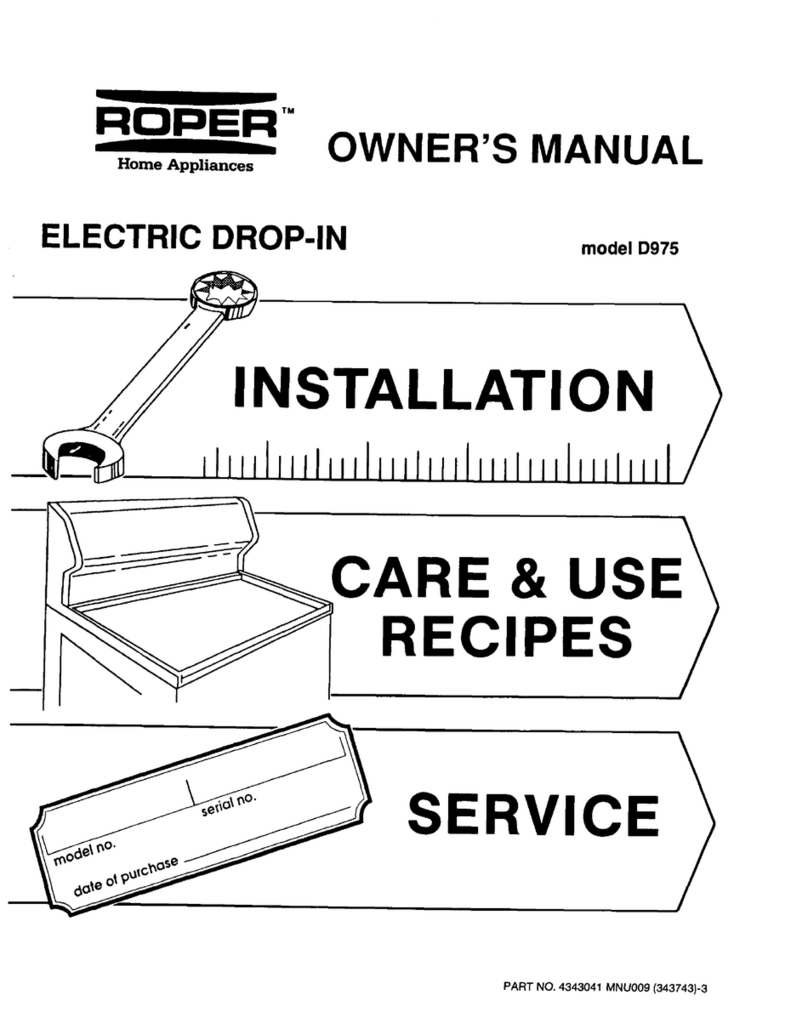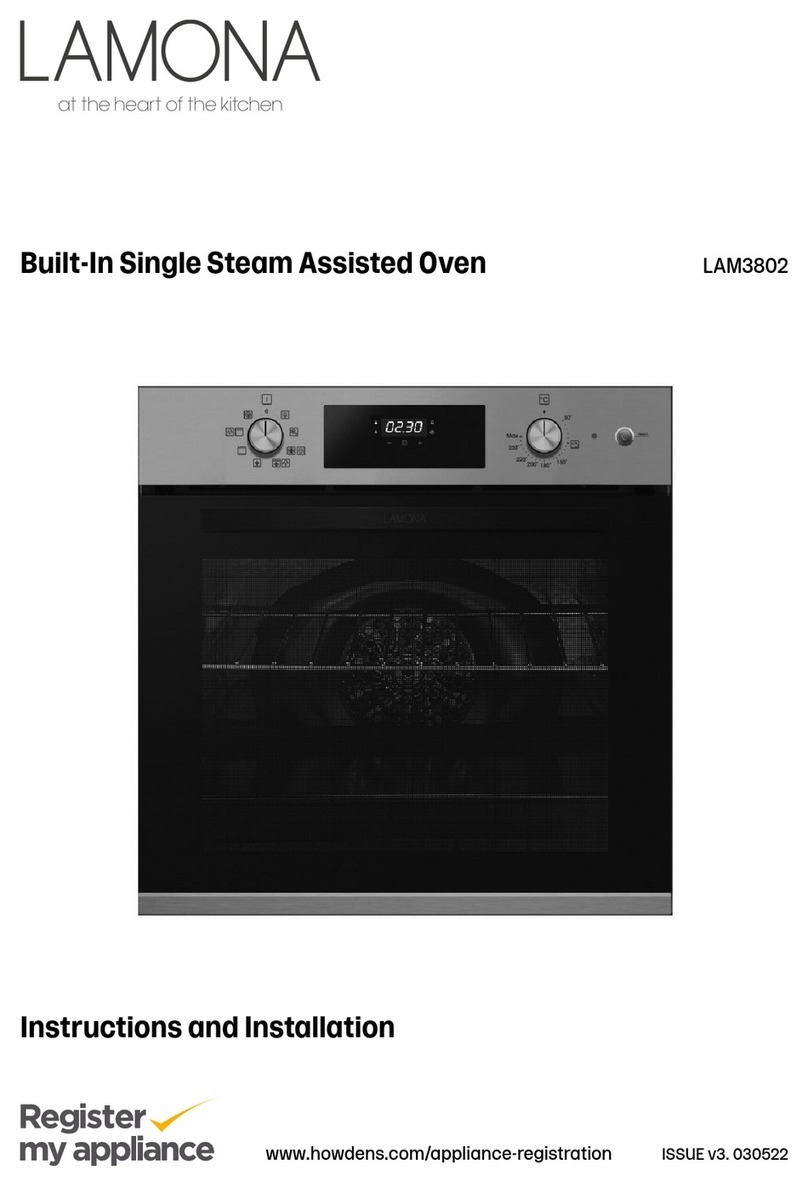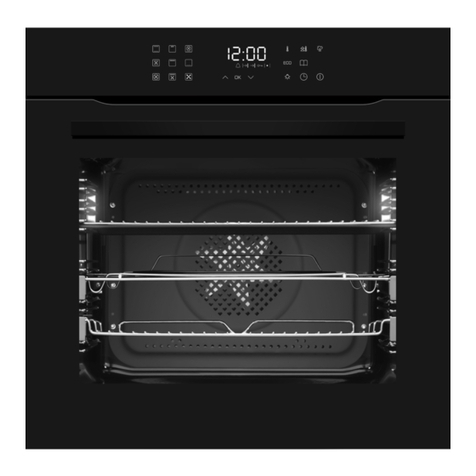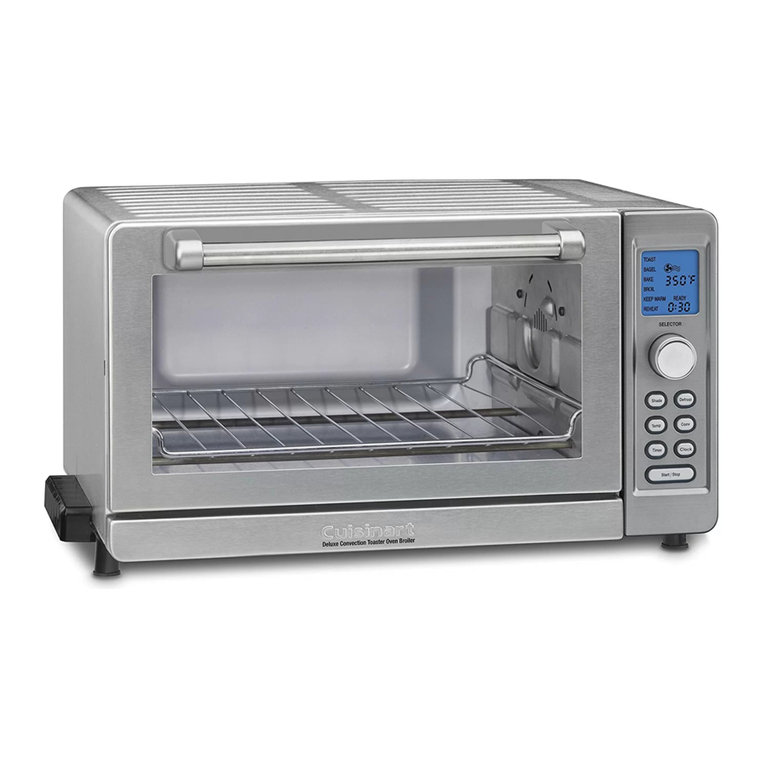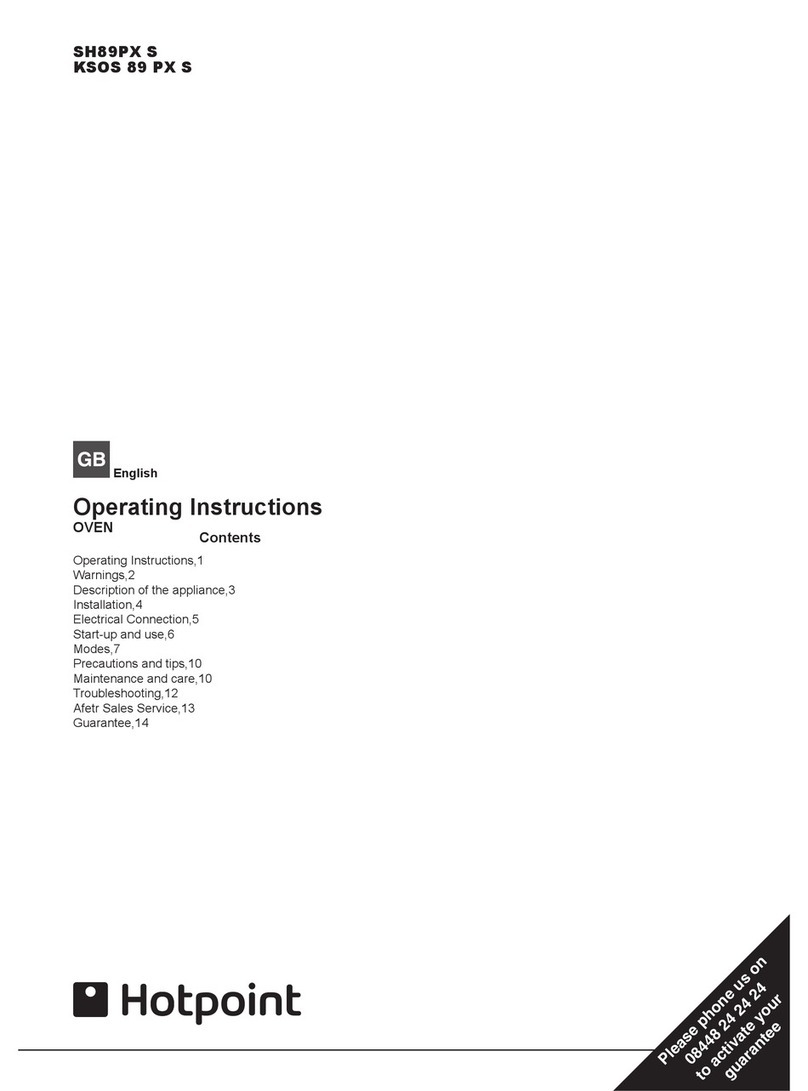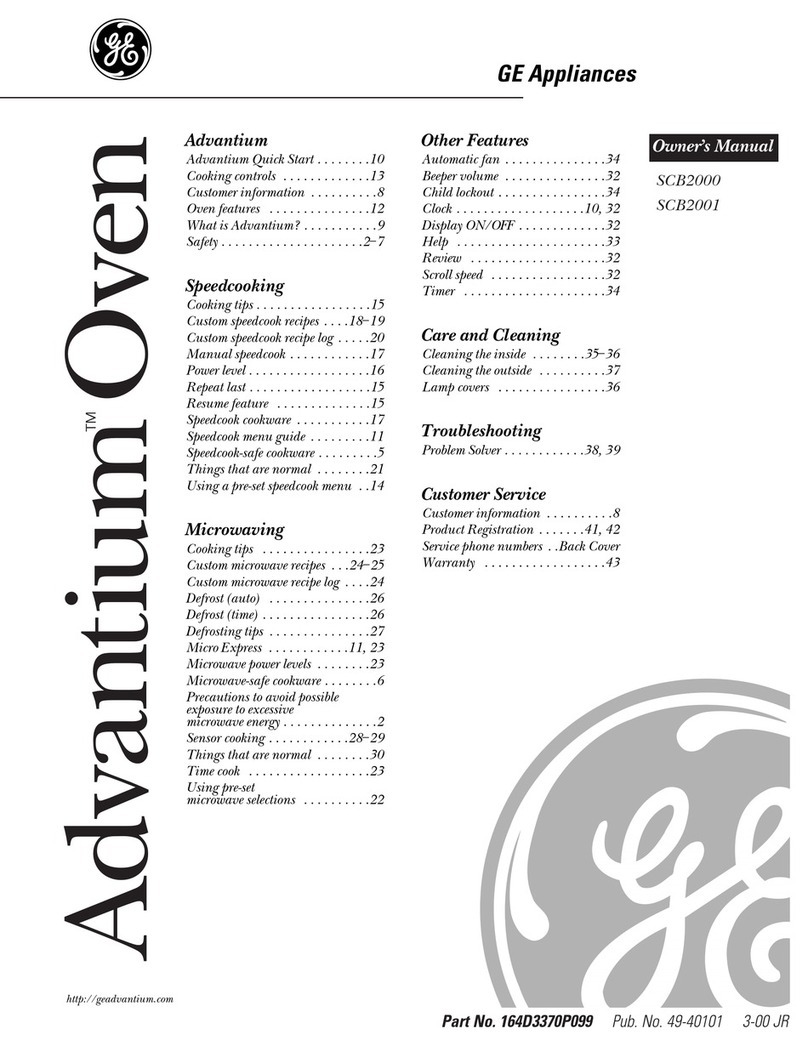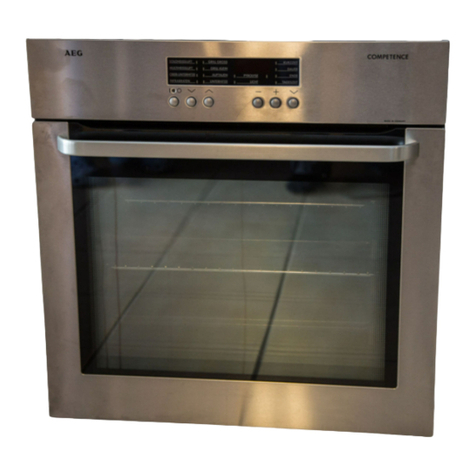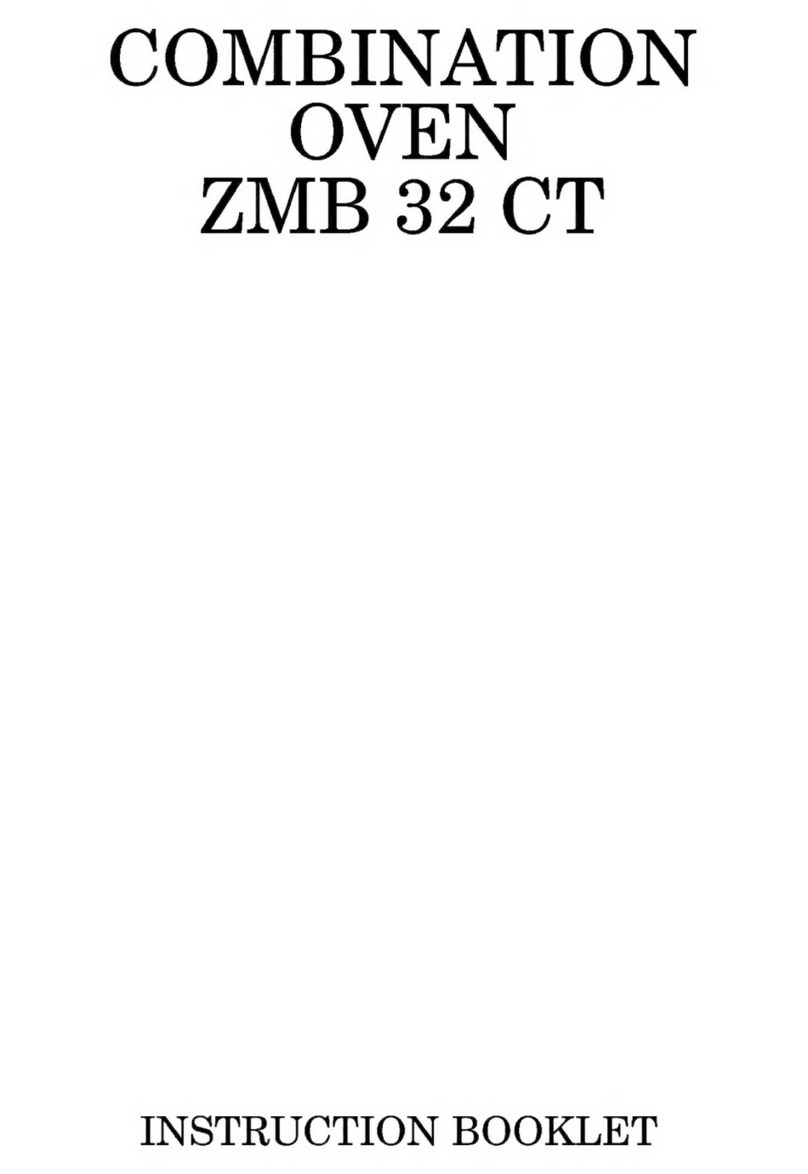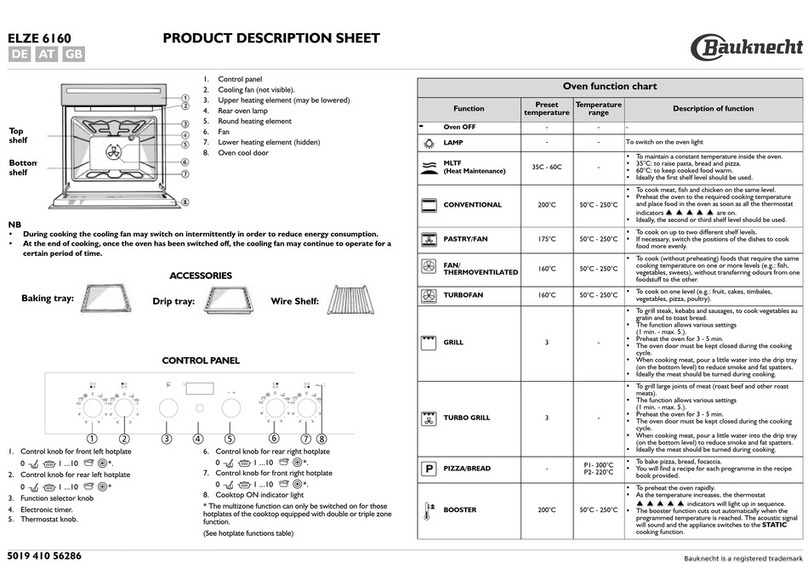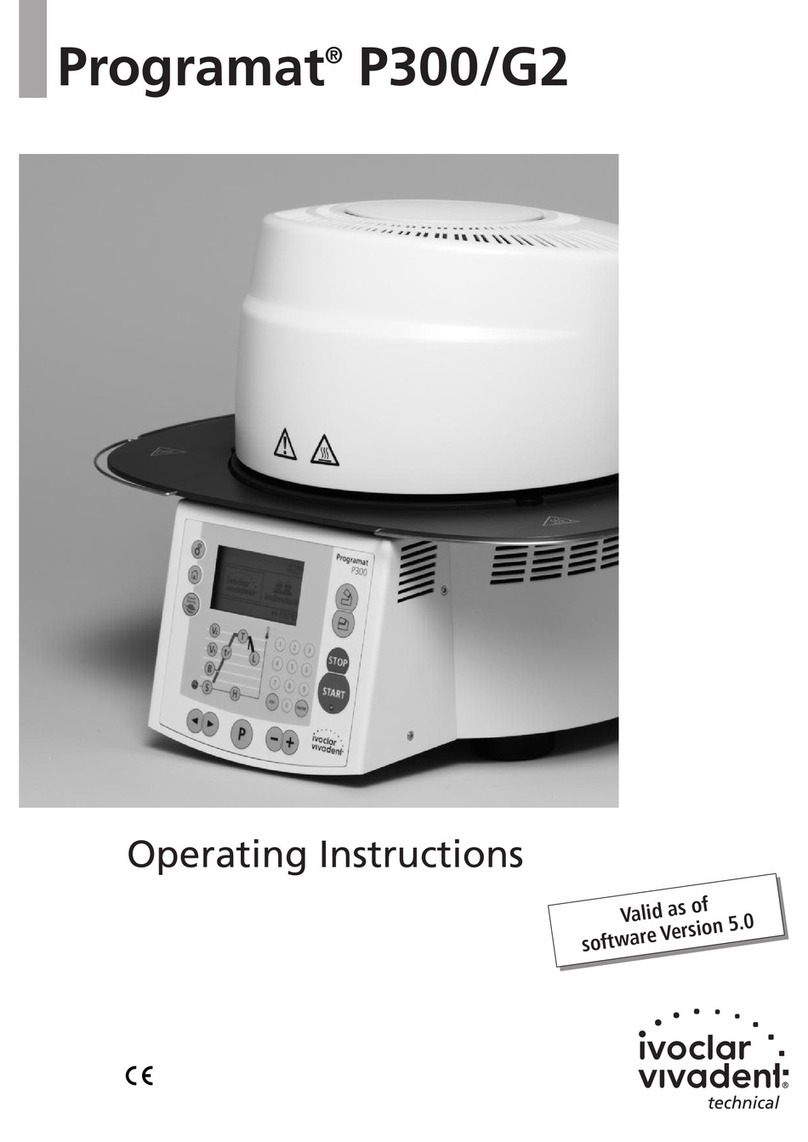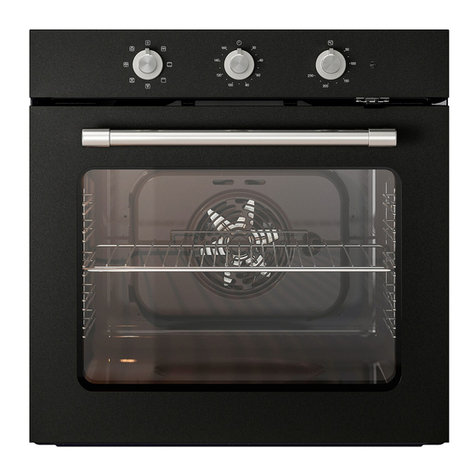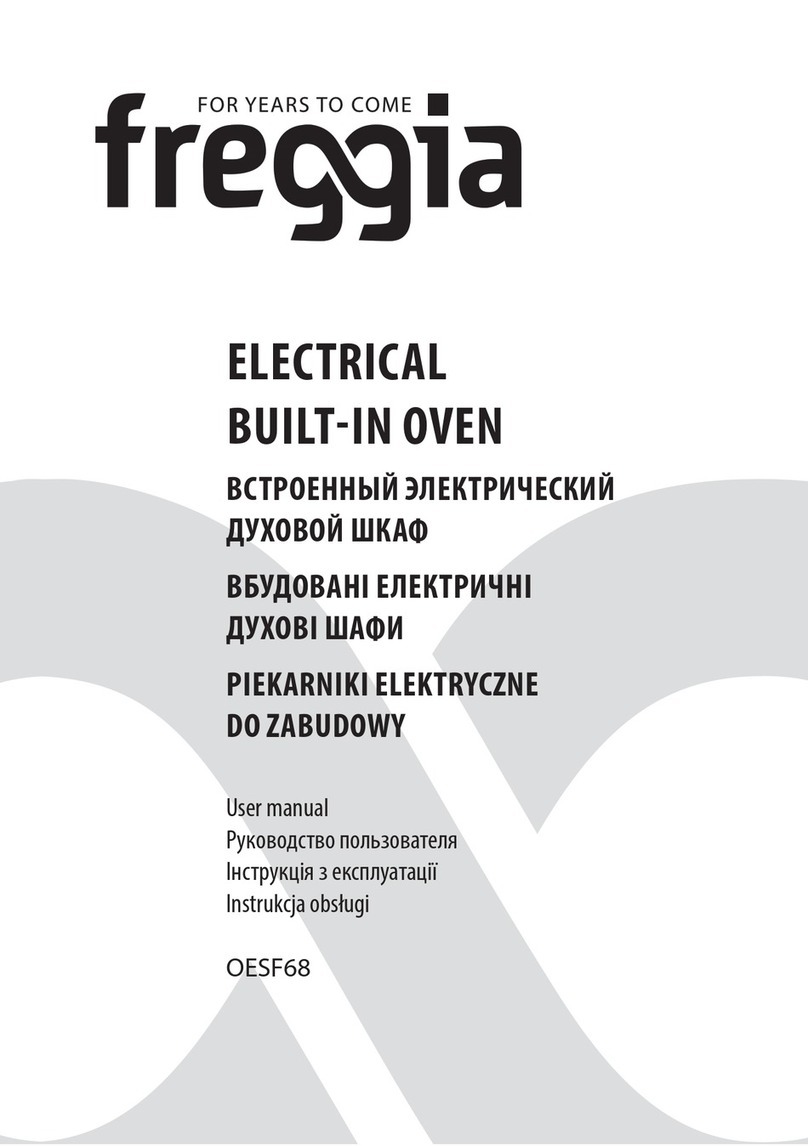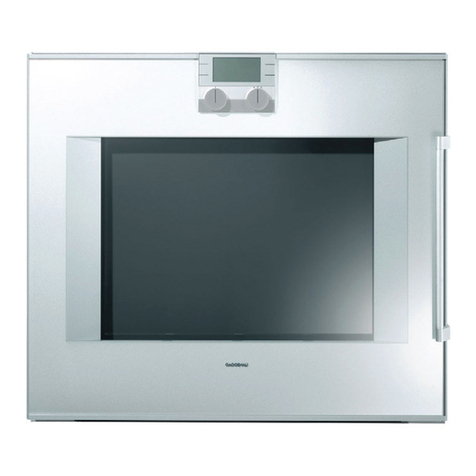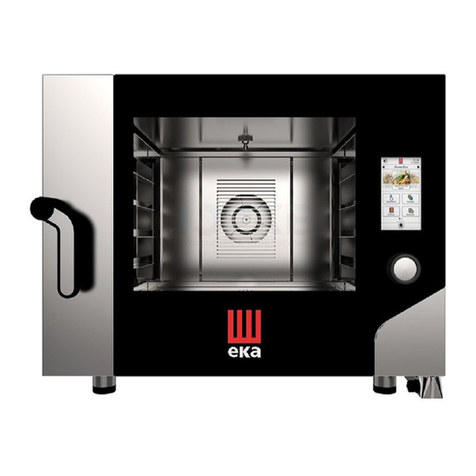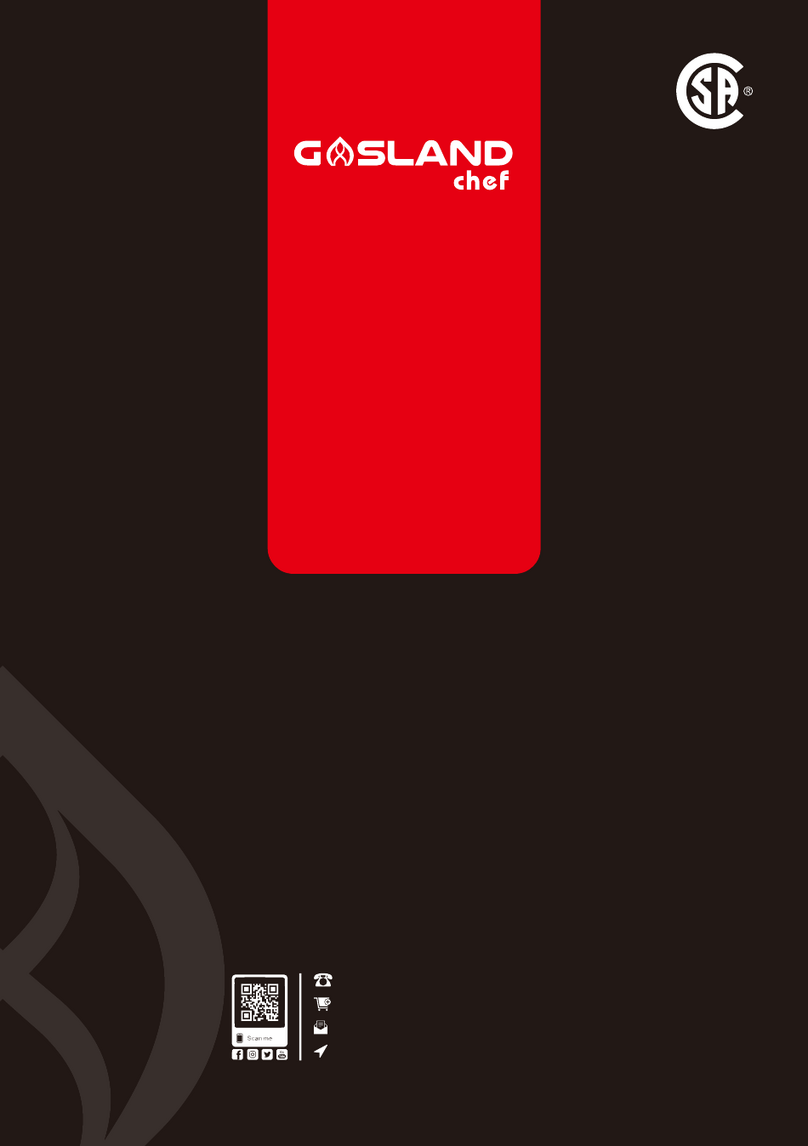Roper B9907X0 User manual

BUILT4iii SELF CLEANiNG *
OVEN - MICROWAVE INSERTABLE
.
USE AND CARE MANUAL .
Copy Your Model and Serial Numbers
IN THE BOX BELOW
Model and Serial numbers are on
a plate on the front frame behind
the oven door. Ifyou call for service,
or with a question, have this infor-
mation ready.
Kee this book, your installation
gui8
e, your warranty and the sales
slip together.
Model No.:
Serial No.:
Purchase Date:--
r/34&p/
991
P&t No. 336t55

.-
SAFETY RULES ...........................
.3-4
BURNERlGNlTlON ..........................
.4
HOW TO USE YOUR OVEN
l
Clock and Oven Controls ....................... .5-6
l
Oven Light ..................................... .
l
Rack and Pan Arrangement ............ :. ........ .7
l
Oven Vent .................................... ...7
l
Moisture. ...................................... .7
l
New Oven Odor ................................. .
l
Preheating ................................... ...7
COOKING HINTS .......................... .8-9
l
Using Foil .................................... ...8
.
Choosing Oven Cookware ........................ .8
l
Common Baking Problems and Causes ............. .8
.
Broiling Tips ................................... .9
l
Positioning Broiler Pan .......................... .9
CLEANING AND CARE . . . . . . . . lo-14
l
Oven Cleaning . . . 10,ll
l
Cleaning Instructions . . . . .12
l
Removable Oven Racks and Guides . . . . . . . .12
. Removable Oven Door . . . .,, . . .13
;
l
Replacing the Microwave Oven Fuse . . . . . . . . . . . . .14
l
Reptacing the Oven Light . . . . . . . . . . . . . . .15
PREVENTING SERVICE CALLS . , . . . . . . . . . .14,15
.
L.P. BURNER ADJUSTMENTS
The adjustments in your Installation Guide must be made before
you try to use your oven.
If you are using Liquified Petroleum Gas (bottled gas) all L.P.
adjustments in your installation guide must be made before use.
If your oven is not properly adjusted, flames may be too high,
or the range may use too much fuel, release toxic fumes or cook
poorly.
FOR YOUR SAFETY
If you smell gas:
1. Open windows.
2. Don’t touch electrical switches.
3. Put out any open flame.
4. Call your gas supplier at once.
I
FOR YOUR SAFETY
Do not store or use gasoline or
other flammable vapors and liquids
near this or any other appliance.

IMPORTANT INSTRUCTIONS
Read the Safety Rules below and all operating instructlons
before using this appliance.
GENERAL
Keep this manual for further use. Y
Be sure your oven is properly installed and-grounbed by
a qualified technician,
Never try to repair or replace any part of the oven unless
specifically recommended in this manual. All other servic-
ing should be done by a qualified technician.
Never block the flow of ventilation air. Always keep oven
vent ducts open for free air flow. The oven vent duct is below
the control panel.
PROTECT YOUR CHILDREN
Teach your children not to play with oven controls. As they
become old enough, teach them to use the oven safely and
correctly.
Never leave children alone or unwatched in an area where
an oven is in use. Children should never be allowed to sit
or stand on the open oven door. Never leave the oven door
open when the oven is unattended.
SAFETY
Never use your oven for warming or heating a room. Such
use can be dangerous as well as damaging to oven
parts.
Never wear loose fitting or hanging clothes while using your
oven. Such clothes may catch fire and cause serious injury.
Never heat &opened food containers. Pressure build-up
may make container burst and cause injury...
Always use care when opening oven door. Let hot air or
steam escape before removing or replacing food.
Always move oven racks while oven is cool. If a rack must
be moved while the oven it hot, do not let the pot holder
touch the hot heatrng element in the oven.
Always use dry pot holders when removing pans from the
oven. Moist or damp pot holders can cause steam burns.
Do not let a pot holder touch a hot heating element. Do not
use a towel or other bulky cloth.
Never touch oven heating elements or interior surfaces of
tr . oven. Heating elements and nearby areas may be hot
enough to burn you even though they are dark in color. Dur-
ing and after use, do not let clothing or flammable materials
touch heating elements or oven surfaces until they have had
time to cool. Other surfaces that may become hot during
use are the oven vent door and the oven door.
3

GREASE FIRES
Always keep the appliance area clear and free from things
that wrll~burn, gasolrne and other flammable vapors and II-
quads. Never store materials In an oven. Flammable Gems
may catch fire and plastic Items may melt and burn.
When brorlrng, always remember to remove the broiler pan
from the oven and clean it when you are done cookrng. If
you leave a broiler pan full of grease in the oven and later
use the oven, you may have a broiler fire.
Never use aluminum foil to line the oven bottom, except
as suggested on page 8 of this manual. Improper use of
these liners may create a fire hazard
PUlTlNG OUT AN OVEN FIRE
If you do have an oven fire, do not try to
move the pan. Instead:
1. Keep oven door closed.
2. Turn oven off.
3. If the fire continues, throw baking soda
on the fire.
Never use water on a grease fire - it will
only spread the flames. Never pick up a
flaming pan.
SELF-CLEANING OVEN
Always remove the oven racks, the broiler pan and other
utensils before a self-cleaning cycle.
Never use any type of commercral oven cleaner or oven
liner protecilve coating In or around any part of your oven.
Do not use any type of aerosol product near-your oven
because the chemical that produces the spraying action.
may, in the presence of heat, cause metal parts to corrode
and could be flammable.
The door gasket is essential for a good seal so care should
be taken not to rub, damage, or move the gasket. Clean
only wrth hydrogen peroxide. See page 10.
Clean only oven parts listed In this manual. See pages 1O-13
for special cleaning instructions.
4

CLOCK AklD OJIEN CQNTROLS
2. Turn SET knob until desired temperature ISdlsplayed. The oven beglns
The lower oven ISentirely controlled 6y the Electronic Range Control. Follow
ltitrucltons below.
TO SET THE CLOCK:
1. Push CLOCK button.
2. Turn SET knob to correct time of day. Clock is now set.
Note: To display the time of day during timed baking, push the CLOCK
button. This will show the time but will not cancel any oven operation.
TO SET THE TIMER:
1. Push TIMER button.
2. Turn SET knob to desired amount of time. The Timer will immediately
begin to count down.
3. When time is up, the end of cycle tone will sound.
4. To cancel the Timer, push and hold TIMER button for three seconds.
This WIII clear the TIMER function. If the “Timer time” was being
displayed, the display WIIIgo to the time of day. If the “Timer time”
was not being displayed, the display will not change.
Note: The Timer is a reminder only and will not operate the oven. You
can use lhe Timer whether or not lhe oven is being used The Timer does
not interfere with oven operations.
TO BAKE:
1. Push BAKE button.
to heat within two seconds, and the display WIIIshow the temperature
as It rises (In 5OF steps). .
3. The Notlflcation Tone will sound when the oven has stabtllzed as the
selected temperature. The display WIIIshow this temperature before
the tone.
Note: To recall what temperature you have selected while the rising
temperature is being shown, push and hold the BAKE button. The
selected temperatuie will be shown while you hold the BAKE button and
will return to actual oven temperature when you release the BAKE but-
ton. You can change the selected temperature at any lime by pushmg
the BAKE butlon and turning the SET knob.
TO BROIL:
1. Push BROIL button.
2. Turn SET knob to HI or LO Broil (see page 9).
3. When finished broiling, push the OVEN CANCEL button.
TO USE TIMED OVEN/DELAY START
Put the food in the oven and program your Electronic Range Control to
turn the oven on and off. Follow instrucIions below and on next page.
CAUTION
Never let food sit for more than 4 hours before cooking starts,
when you se1 your oven for a delay start. Room temperature is
ideal for the growth of harmful bacteria. Be sure oven light is off
because heat from the bulb will speed bacteria growth.
Note: To cancel any timed oven operation, push the OVEN CANCEL
5 button.

TO START NO’/.’ AND STOP LATER:
1 Push CQOK TiME butron
2 Set lengtn 01 bakrng time wllh SET knob.
3. Push BAKE buttor
4 Set desrred temperature wrth SET button
5 When COOK TIME IS reached, the end 01cycle tone WIIIsound and
Ihe oven WIIIturn off
Note: You can push the STOP TIML button to find out when the end
of cycle will sound and the oven WIII turn off.
TO START LATER AND STOP LATER:
1. Push COOK TIME button.
2. Set length of bakrng trme wrth SET knob
3. Push STOP TIME button.
4 Set trme of day when bakrng should be completed with SET knob.
c 5 Push BAKE button.
? 6. Set desired temperature wtth SET knob.
0
7. When STOP TIME ISreached, the end of cycle tone WIIIsound and the
oven WIIIturn off.
5 Note: You can push the STOP TIME button to ftnd out when the oven
: WIIIturn off. Push and hold the COOK TIME button to find out when the
oven wtll turn on.
! When a lunctton has been entered, you can recall what has been pro-
3 grammed by pushing the corresponding functton button. The messages
In the display show you whtch function IScurrently betng displayed. Whtle
s
the function ISdtsplayed, you can change It wtth the SET knob. You can
change any programmed function at any ttme.
3 Never slide the door IocWunlock handle into the LOCK posrtron whrle try-
tng to bake or brotl. You will not be able lo program your oven to bake
or broil if the oven door ISlocked. If you try to lock the door whtle the oven
IS on, the oven will tmmedlately turn off 6
TONES
End of Cycle Tone (3 long beeps one second on, one second on)- sho’ws
that a trmed oven operation has reached STOP TIME or that the Timer
has counted down.
Attention Tone (serves of short beeps, one quarter second on. one quarter
second off. until proper response IS grven): WIIIsound If oven has onty
been parttally programmed. For example, 11you have selected a COOK
TIME btt no temperature, you WIIIhear the attention tone unftl you select
a temperature or push OVEN CANCEL.
Notification Tone (single. one second beep). shows that the oven has
stabtltzed at the selected temperature.
Key-tone (single. one tenth second beep). sounds when any button IS
pushed.
Failure Tone (series of very rapid beeps one erghth second on, one quarter
second off): display will show FO-FE. Cancel fatlure tone by pushtng the
OVEN CANCEL button. If the failure occured whtle you were programm-
ing the Electric Range Control, push the OVEN CANCEL button and try
agatn. If you still get a farlure tone that does not stop after 16 seconds,
call for servtce. If you are unable to cancel the fatlure tone wrth the OVEN
CANCEL button. unplug the range or dtsconnecl the ctrcutt breaker.
If you prefer that your range not have an audtble tone at the end of a cycle
or when you push a button (Key Tone), you can eliminate the End of Cy-
cle and Key Tone by pushing and holding the OVEN CANCEL button IJ~
111you hear a short beep (in approxtmately two seconds). If you wtsh to
activate the tones again. push and hold the OVEN CANCEL button or-kce
more until you hear a short beep. Cancelling or actrvattng the tones should
only be done when there is no oven operatton programmed. Pushtng the
OVEN CANCEL button wtll clear all functions except the clock and Timer

OVEN LIGHT.
The swllch on the control s&x9 rurnslhe oven I!glll on and off See page
15 Ior more Inlormatlon. !’
RACK AND PAN ARRANGEMENT
Put oven rack(s) In place before rurnlng on lhe oven Rack posr!lonS are
numbered starting at the bottom with number 1 In general, when using
only one rack In the lower oven, posltton No. 2 should be used. When
using two racks, posItions No. 2 and 4 work best
Pans too close to each other, IO oven walls or to the oven bottom blbck
the lree movement of air. Improper air movement causes uneven brown-
q and cookIng.
Normally there should be 1% to 2 inches of air space on all sides of each
pan In the oven. Sea tips below.
Sheet Cake, Cookies.
Blscults The pan or
pans using
the least rack
area should
be dated on
‘t-----! the. lower of
the two racks.
Cake Layers. Pies,
Casseroles. 3 Pans
on one rack In
the lowest
Angel Food or
Sponge Cake When using
two racks and
several pans,
stagger them
so no pan IS
directly above
another.
Cake Layers, Pies,
4 Pans (staaaeredl
OVEN VENT
When the oven ISon. air moves lhrough a vent below (he conlrol panel.
This hot air may make controls hot.
The vent ISneeded for proper air flow In the oven and good baking results
Do rot block this vent. Doing so may cause cookng Mure. (Ire and damage
to the range.
MOISTURE _.
As your oven heatsiip, water droplets may form on the door or door glass.
To prevent this. openthe oven door for the llrst minute of oven heat up
to let the moist air out.
NEW OVEN ODOR
During the first baking and broiling cycles on your new oven, there may
be some odor. This is normal and is caused by the heating of new parts
and insulation. The odor will go away wlthin a short time. A vent fan or
other ventilation will help to clear the air.
PREHEATING
Preheating lets the oven heat evenly before the food IS put in. Allow 10
minutes at temperature less than 35oOF. and about 15 minutes at
temperatures at 35oOF. or more.
With recipes that call for an oven preheated to a certain temperature. It
is very Important that you follow those instructions. It is not likely that you
will get good baking results every time wlthout preheating to the needed
temperature, unless the recipe says to start in a cold oven.
After the oven is preheated and you are ready to put the food in, try to
have everything handy so that you will not have to leave the oven door
open for an exlended period of time.
Opening the door to check the food during baking makes it impossible
for the oven to stay at the temperature you have selected. Try lo lime your
baking and chedc only when close to being litxshed.
NOTE: Whenusing m made of ovenproof glass or pottery. TefIon
coated ware or dull or darken+ pans in the oven. be sure to reduce
recipe temperature by 25OF. (s-s Choosing Cookware page 8).
7

tJSING FOIL
To catch splllovers. GUIa piece of loll sltghlly larger than the pan and lurn
up Ihe edges use IWOoven racks and put rhe loll on Ihe lower oven rack
below Ihe pan Do not use aluminum loll dtreclly under a pan on the same
oven rack The loll wll rellecl heal away lrom the pan
.A
Do not cover the oven bottom or an entlre oyen rack
with foil. The fool can block normal heal flow, cause
cooking failures. and damage the oven rnterior
For Roastrng
For sbw bmwnrng, place a fol “tenr” l&y over the meal This ISesfHZlal-
ly QCCK!on a large turkey The “renr” lets oven heal clrculare under Ihe
f&c Sealtng rhe io~l WIIItend IO sIeam the meal
To reduce spattering, lightly crush 1011and pul I!M-Ithe bollom of Ihe pan
under Ihe load
For Brollinq
Do not cover the entire brorler grid with foil. Poor
a
drainage of hot fat may cause a broiler fire.
If a fire starts, close the oven door and turn controls
off. If fire contrnues. throw baking soda on the fire. Do
not put water on the fire.
CHOOSING OVEN COOKWARE
ALUMINUM: Absorbs heat faster than glass or steer and conducts heat
well. Gives delicate browning, tender crusts. and reduces spattenng of
v) roasts. Best for cakes. muffins, qurck breads. cOOkies and roasting.
CI OVENPROOF GLASS/POTTERY: Because this cookware absorbs and
c holds heal well. you should tower your oven temperature 25eF. Gives a
-
I food a deep, crusty brown top. Best for casseroles
m TEFLON@ , DULL OR DARKENED COOKWARE: Absorbs heat quicker
than shiny a&ware. Lower your oven temperature 25FD(exw for pastry).
c Good for pres and olher loads baked in pastry shells.
COMMON BAKING PROBLEMS AND CAUSES
CAKE RISES UNEVENLY BOTTOM PIE CRUST
- Aanqe or oven rack no1 SOGGY
led
l
Pan warped
l
Batter spread unevenly rn
Pan
l
Pan too close to oven
walt’or rack to crowded
CAKE HIGH IN MIDDLE
Fllllng loo ,uxy
Fllllng allowed IO sland I”
pe shell before baking
Used shmy pans
Temperature too low at
start of bakng
Crust and/or frllrng not
ah+& to Cool before 1111.
rng crust
l
Too much flour
l
Oven temperature too
high
CAKE NOT DONE IN
CENTER
l
Wrong pan srze
l
Oven loo hot
l
Pan not centered rn oven
BURNING AROUND EDGES
OF PIE CRUST
CAKE FALLS
TOO much shortening, Ii.
quid or sugar
Temperature too low
Pan too small
Oven door opened too
often
Too much leavening or
stale feavening
0v~~mixir-g after adding
-;.
l
Oven temperature 100
hrgh
l
Edges
of
crust loo thin ur
loo high
l
Oven loo full or pans too
close
together
c0miE.s
AND BISCUITS
BURN ON BOTTOM
l
Oven preheat trme 100
ShOfl
l
Pan too deep or too large
l
Used dark pans
l
Used wrong rack posnion
FOOD NOT DONE AT END
OF COOKING TIME
l
Oven temperature set too
low-
* oven loo crowded
l
Oven door opened too ’
often
l
Alumrnum forI blocking or
movement
a

BROILING TIPS
l
Your oven door shoutd be open lo the slop pos~l~on whrle brorlrng. Ii
the door ISclosed the lood ~111loasl Instead 01 brorl (see page 13).
b Use only Ihe brotler pan and gnd lurnrshed wrth your range for brorllng
- They are desrgned for proper drainage 01 fat and lrqurds and help pre-
vent spatter, smoke or Irre.
l
Do not preheat when brorltng For even brorlrng on both sdes. start Ihe
food on a cold pan. Allow slrghtly more than hall the cookrng lime lor the
lrrst sde then turn the food usng tongs. If you pterce the meal with a lark.
Ihe jurces wrll escape. .I
l
When broiling frozen meat. use one rack posrtron lowerthan recommend.
ed up lo 1% trmes the suggested brorkng ttme.
l
Tnm the outer layer of lat lrom steaks and chops. 91 the fatty edges to
keep the meal lrom curlrng.
l
Always put the lood berng brorled on the proper rack. (see chart at nght.)
Food placed loo close to the broiler may spatter, smoke or calch fire.
. For maxrmum luctness. salt the lrrsl srde lust belore turning the meal. Salt
the second srde tust before servrng.
6 Brush chrcken and ksh with butter several limes as they broil. When broiling
Lsh. grease the gnd to prevent sticking.
l
Never leave a soiled broiler pan in the range. Grease In the pan may
smoke or lgnlte the next time oven ISused. See page 12 for bps on clean-
ing Ihe brorler pan and gnd.
. Be sure you know the correct procedure for puttrng out a grease lire.
See Page 4.
POSITIONING BROILER PAN
Brorlrng IScookmg by direct heat from the upper oven element. Tender cuts
01meat or mannated meal should be selected lor brorlrng. For best results
steaks and chops should be al least %I” thck.
Alter placrng lood on the broiler pan, put the pan on an oven rack in the
proper posrtion. The recommended rack posrlron and cookrng ttme can be
lound In the char-l below.
Most foods can be brotled on the HI setttng. Select the LO brorl settrng to
avoid excessive brownrng or dryrng of foods that should be cooked lo the
well done stage (such as thrck pork chops or poultry).
The closer the food
IS
to the brorl element the faster the meat browns on
the outsde. yet stays red to punkIn the center. Moving the meat farther away
lrom the element lets the meat cook lo the center while brownrng outstde.
FOOD
RACK
POSITION
4 = HIGHEST
-1= LOWEST
\I
TOTAL TIME 00
(MINUTES) I.
k
Steak 1” Thrck..
Chicken (Halves) 1 40-60
Franklurters 3 10-15
Bacon 3 5.7
Open-lace Sandwrches 2 6-10 I
This chart is a general guide. The size, weight. thickness and starting
temperature of the too& as well as your own personal preference, will
effect the desired cooking.
9

THE, SELF-CLEAN CYCLE
1
Remove the brorl pan and gnd. ovenracks. all ulenslls and any loll
that may be In the oven If oven racks are left rn rhe range dunng a
clean cycle, they wll darken, lose therr luster and become hard lo slrde
2 So11on the oven front frame, under the front edge of the cookrop. the
door kner outside the door seal and the front edge of the oven cavrty
(about 1” nlo Ihe oven) WJIIno1be cleaned durnrng a clean cycle (see
Ittusrralron below) Clean these areas by hand belore stanng a clean
cycle
Use derergent and hot water wrfh a soap-frlled steel wool pad, lhen
rinse well wrth a vrnegar and water mnrture .Thrs WIIIhelp prevent a
brown resrdue from lorrnrng when the oven IS healed
Before A Clean Cycle
3 Wipe up heavy spllovers on Ihe oven bottom Too much so11may cause
smokrng dunng the clean cycle
4 Clean lhe door seal by ustng a clean sponge to soak fhe sorled area
wrlh hydrogen peroxrde Repeated soakrng may be needed depen-
drng on the amounl of so11Frequenr cleanrng WIIIprevent excessrve
so11burld up. Do no1 rub the door seal excessrvely. The fiberglass
malenal of the seal has an extremely low resistance to abrason Any
cotton matenal especrally (rncludrng cottonballs). can east1 rub a hole
Into the seal Do not use any cotton materials to clean t
1e seal An
rnlact and well l#trng oven door seal IS essentral for energy
efficient oven operatron and good bakrng results If you noltce the seal
becomrng worn. lrayed or damaged In any way or II It has become
drsplaced on the door you should reolace Ihe seal.
10
DO NOT use commercral oven cleaners or oven protectors In or near the
oven These products plus the hrgh tremperarure 01the clean cycle may
damage the porcelain frnrsh
DO NOT clean glass ceramrc cookware or any other cookware In the oven
dunng a sellclean cycle
IMPORTAilT INFORMATION
All controls must be set correctly for the clean cycle to work properly To
help you understand how the clean cycle works, the stages 01the cycle
are noted below
1 Th6 controls are set and the door lock handle moved rtght Into the
lock posrtron
2 The oven begrns to heat
3 For your safety, when the locking temperature IS reached rhe over.
door can not be opened (the word LOCK WIIIbe on In the Electronic
Range Control dtsplay)
4 When the 3% hour clean cycle IS over the oven begtns lo cool
5 When the lemperalure has lallen below lockrng temperature (aboul
20-30 mrnutes after oven goes off at end of clean cycle) the door can
be opened
I
I
After a cleanrng cycle, the oven door cannol be unlocked 1
unless:
The temperature has had lime lo drop to a safe level and
the word LOCK is off in the Electronic Ranae Control disolav I
I
(20-30 minutes)

TO SET A.CLEAN CYCLE
The sell cIean\nq cyclws preproqrameo lr)r 3% hours You Can also set
the elecironlc range conlrol lor a
‘deldved
start 01rhe clean cycle
To self-clean
1 Slide the door lock handle to Ihe right You may need to press the
door slfghtly lo get II to lock properly
Never It-y lo force fhe door lock handle Forcing the handle may
damage the door IoCklng mechanism
2. Push CLEAN button The oven begins to heat wlthln 2 seconds
Note: You can llnd out when the clean cycle will be llnlshed by pushing
the STOP TIME butlon
To use delayed sell-clean:
1 Push STOP TIME button
2 Turn SET knob IOtime 01day when you wish cleaning to be completed
(must be more than 3% hours later than current tlme ol day)
3. Slide Ihe door lock handle lo fhe rIghI. You may need lo press Ihe
door sllghlly lo gel
II IO
lock properly. Never lty lo force the door
lock handle Forcing lhe handle may damage the door lockmg
mechamsm.
4 Push CLEAN bulron
Note. Dunng a delayed sell-clean operation you can tend out when the
oven turns on by pushtng and holding the CLEAN butIon
TO STOP A CLEAN CYCLE:
1 Press rhe OVEN CANCEL butlon 0
2 wat until the oven has cooled below the locking
lempWalUW (20-30 z
minutes) and the word LOCK
IS
OHIn the Electronic Range control
&splay 4
3 Slide the door handle IeR 10unlfxk Ihe door You WIIInot be able lo T
unlock the Oven
UhleSS
the oven temperature 1sat a safe level Never tn
force lhe door IocWunlock handle 5
WHEN A CLEAN CYCLE IS FINISHED a
1 Walt unlll the oven has cooled below lccklng temperature (20.30 0
minutes) and the word LOCK ISotl In fhe Etectronlc Range Control
display e
2 Slide the door IocWhandle left to unlock the door You WIIInol be able (0
to unlock the oven unless the oven temperature ISat a sale level Never
force the door lock handle
Note: II the door does not unlock because the temperature has not had
time IO drop IO a safe level when you llrst try to open the door. be sure
to slide the door lock/unlock handle back all the way to the right
AFTER A CLEAN CYCLE
After a clean cycle, you may nolIce some white ash In the oven Just wipe
II up with a damp clolh
If white spots remaln, remove them with a soap-Illled steel wool pad Be
sure to rinse thoroughly with a vinegar and water mlxture These deposits
are usually a salt residue thal can not be removed by the clean cycle
II the oven ISnot clean atler one clean cycle, the cycle may be repeated
11

CLEANING INSTRUCTIONS
CONTROL PANEL
Wash with soap tlnd water, rinse then dry with a paper
towel.
OVEN FINISHES
SELF-CLEANING Use soap, water and a”scounng pad
for touch up cleaning between self-cleaning cycles. Give
a flnal rinse with vinegar and water. Avoid any contact with
oven door seal (see below). Never use any oven cleaners.
OVEN RACKS: Remove from oven (see instructions on
page 12) and wash at stnk with soap, water and a scouring
pad.
BROILER PAN AND GRID: Do not leave In range to cool.
If you soak right away, clean-up will be easier. Remove pan
from oven and remove fat and drippings. Sprinkle pan wtth
detergent then cover with a wet cloth or paper towel and
let soak. Later wash in soap and water using a scouring
pad as necessary. Both the pan and the grid are dishwasher
safe.
OUTSIDE FINISHES
CHROME: Wash with soap and water. A chrome cleaner
may be used.
GLASS: Wash with a damp, soapy cloth. Remove stubborn
sot1with a paste of baking soda or ammonia and water. Do
not use abrasive matenals. Before using an all purpose
cleaner, check the label to be sure tt
IS
recommended for
glass-some will permanently damage glass.
12
REMOVABLE OVEN RACKS AND GUIDES
Be sure not IOscratch the oven flnlsh when lnslallmg or removing oven
racks.
To InsraIl:
PUI Ihe pegs on the end 01Ihe rack guide ~nlo the holes In lhe oven
back
Lock Ihe Iron1 hook In Ihe slot In the oven side
Sel the raised back edge 01 the oven rack on a Parr 01 rack guides
SOthe hooks al Ihe sides of the rack run underneath the rack guloes
Push Ihe rack In until you reach lhe bump in Ihe rack, lhen Ilh Ihe front
of the rack a bit and push Ihe rack all the way in
To remove:
1 Pull the oven rack out, then
up,
In one motion
2. Llfl Ihe front of the rack guide to unhook II from the oven wall and pull
out
See
Ihe
cleaning
InstructIons on page 12
RACK HOOK RACK
BUMP

REMOVABLE OVEN DOOR
The o\en doors c& be rf moved for cleaning
To remove:
1 OClen the door to the t roll stop position and grasp the
door al each srde (set? rllustration).
2. LIP’the door up a bit. then pull straight toward.you.
To replace:
1 Make sure that hinge arms are In posrtion B (broil stop
posItton).
Note: If a hinge arm snaps into position A, it must be
moved back to position B before the door can be
replaced.
2. Carefully insert the hinge arms through the openings
in the front frame and push the door into place while
holding the door up.
3, When the bottom edge of the door is flush against the
front frame, allow the door to settle into place.

REPLACING,
OVEN FUSE THE MICROWAVE
Below the mrcrowave oven there IS a fuse to protect the
mrcrowave oven from malfunctrons In the electrtcal system
or components.
If your lower oven works but your mtcrowave oven WIIInot
work:
1.
2.
3.
4.
5.
Check your mrcrowave oven manual to be sure you
have followed operating instructions exactly.
Remove the two screws in the side tnm and the two
screws In the vent tnm and remove the vent trim/vent
box assembly.
If there is no adjacenter counter or table, move a chair
close to the oven. Remove the microwave oven and
place it on a counter, table or chair.
Replace the old fuse with a 15 amp, type S fuse
Loft
the microwave oven and slide back into place above
the lower oven. Be careful not to pinch or damage the
mlcrowave oven cord on the back of the lower oven
when sliding the microwave oven back into place.
VENT TRIM
FUSE
If your microwave oven still will not work, or if it blows
another fuse, call for service.
14

RETAINER -
GASKET
REPLACING THE OVEN LIGHT
-_
&I nor louch oven bulb when hol. with wet hands, or wipe oven light
area wllh wel cloth. Unplug or disconnecl the electrical supply IO oven
before removing.
Never touch the electrically live collar on the bulb when replacing il.
Elecfncal power musl be shut off II you have lo replace a broken bulb.
1 Remove the lhree screws and Irftoff the glass~elalner and glass cover.
2. Replace the bulb wfth a 40 watt applfance bulb. An applrance bulb
IS smaller lhan a standard 40 watt household bulb.
3. Replace the gasket, glass cover and glass relarner. Tfghten screws
securely
IF YOU HAVE A PROBLEM
Problems are otten caused by lfttle thongs that you can frx yourself wrthout
any
tools.
Make sure you are lollowfng fnstructtons In lhfs book and read
the list of common problems and soluflons on this and the nexl page. 3?
If you have a problem you can
fix
yourself call your Roper Dealer for help.
CLOCK/TIMER DOES NOT WORK !i
l
Check to be sure range cord ISplugged Into outlet completely. Check ti
for blown (use or tripped cfrcuit breaker. c)
l
Check for power outage
l
Check step by slep operating lnstrucllons on pages 5 and 6
OVEN LIGHT WILL NOT WORK 3
l
Check lo be sure range cord is plugged into outlet completely. Check
for blown fuse or tripped circuit breaker.
l
Check for power outage. z
l
Check for loose or burned out bulb. See page 15 for replacement m
instructions
OVEN TEMPERATURE SEEMS INACCURATE s
2
l
Is proper atrflow blocked by aluminum loll? See page 6 for Ups on cor-
rect use of foil.
l
Is the oven venl blocked? See page 7.
l
Check the secllon on baking problems and causes on page 6 T
=
l
The oven thermostat on your new range may be more accurate than u)
the one on your old range. See page 16 for fnformatron on adfustrng
fhe Oven femperature.
15

OVEN/BROILER ELEMENT DOES NOT WORK
m
l
speck
for cower ‘&rage Chxk lor blown fuse or tripped clrcull breaker
l
Are cormols set correclly? See pages 5
dnd 6
RANGE IS BEEPING d
l
See Ihe secllon on Tones. page 6
BROILING PROBLEMS
. Oven Control knob not set to BROIL. See pages 5 and 6.
l
Usmg wrong rack position. See chart on page 9.
l
Alummum 1011not used properly and grease can’t dram correctly
See page 8.
OVEN DOOR WILL NOT UNLOCK AFTER CLEANING
l
The door WIIInot unlock untrl the oven has cooled to a safe temperature.
See page 11 lor rnstructlons on unlcckrng the door.
OVEN WILL NOT SELF-CLEAN
l
Oven controls not set properly. Review step by step instructions on
page 11.
l
Heavy spillovers were not wiped up before starting clean cycle. See
page 10.
l
Oven too dirty - should be cleaned more often. 16
ADJUSTING OVEN TEMPERATURE
The temperature In your new range has been set correctly at the Iactor\
so be sure lo follow the recrpe lemperatures and flmes the 11rs1few tlmec
you bake In your new oven.
II you lhlnk the oven should be hotter or cooler, you can adlust II yourself
To deade how much to change the temperature, set the oven temperature
2YF hrgher’or lower than the temperature rn your recipe. then bake. The
results of thts “test” should grve you an Idea 01how muchThe temperature
should be changed,
To adjust temperature:
1.
2.
3.
4.
5.
Push the BAKE button.
Select a temperature between 5OCPFand 55PF with the SET knob.
Quickly (within two seconds, before the BAKE function energizes1
push and hold the BAKE button.
The display will go blank and then WIIIshow the amount of degrees
difference between the onginal factory temperature setting and the
current temperature setting. If the oven temperature has never been
adjusted the display wrll read 00.
The temperature can be adjusted up to 35OF hotter or 3YF cooler
in 5OF steps. A minus sign (-) before the number means that the
oven will be cooler by displayed amount of degrees.
When you have made the desired adjustment, push the CLOCK
button to go back to the time of day display or use your oven as
you would normally.
Note: The self-clean temperature will not change by the adjustment
described above.
This manual suits for next models
1
Table of contents
Other Roper Oven manuals
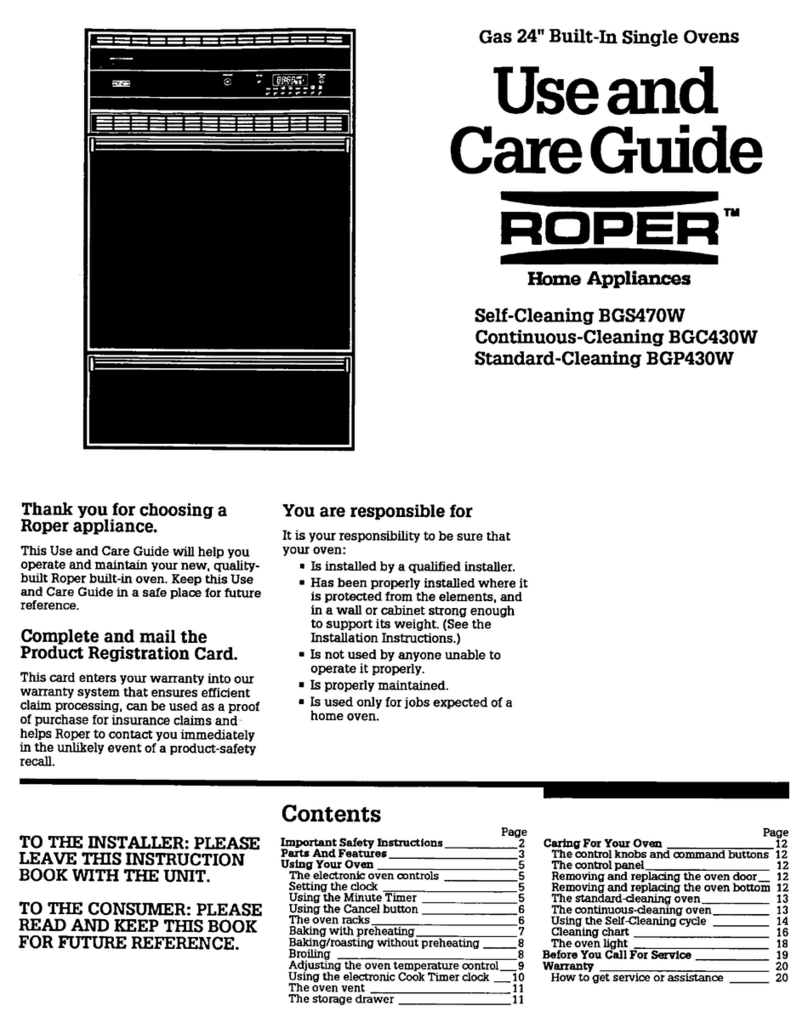
Roper
Roper BGC430W BGP430W User manual
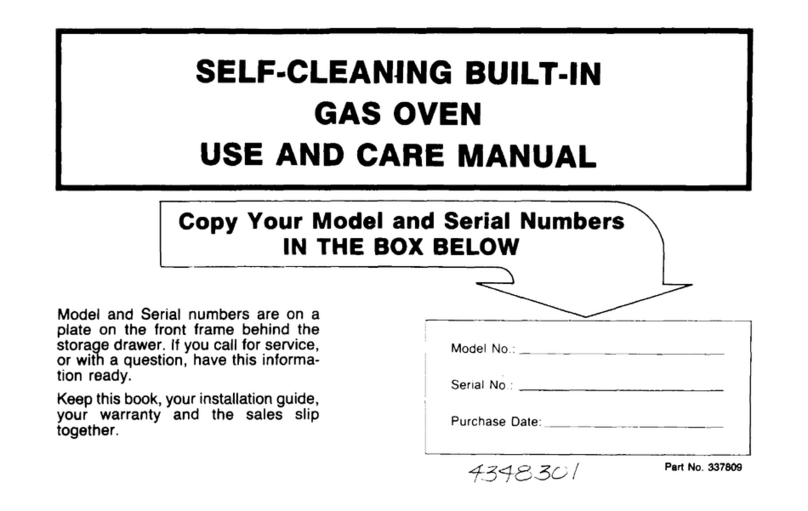
Roper
Roper B8758B0 User manual

Roper
Roper B4007B0 User manual

Roper
Roper B500 User manual
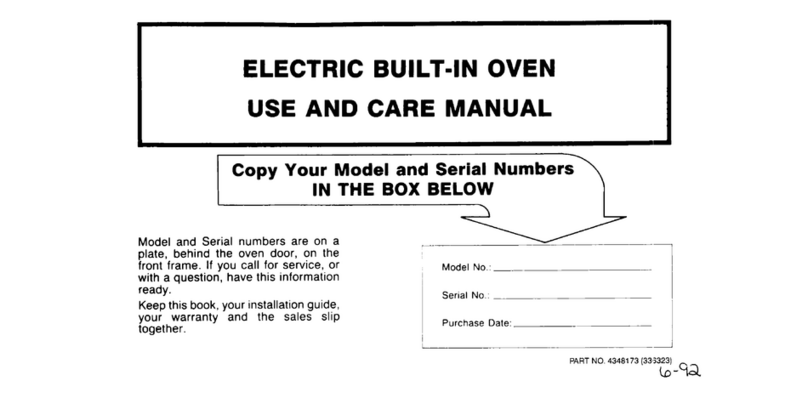
Roper
Roper B5007X0 User manual
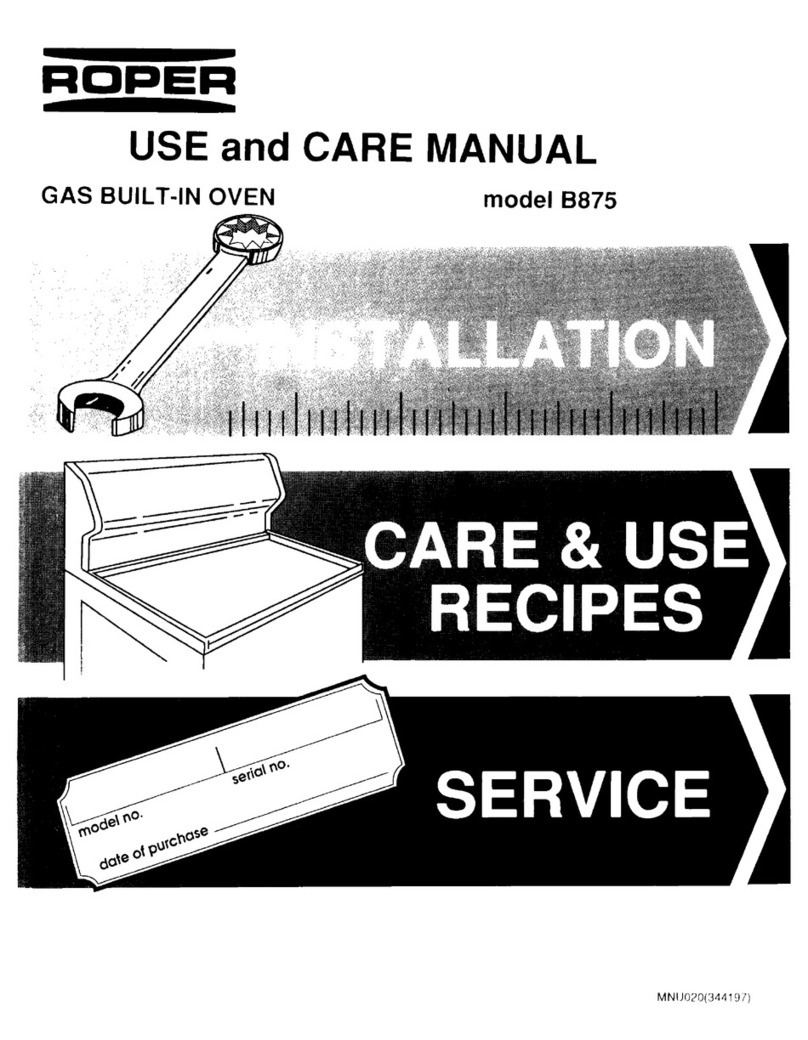
Roper
Roper B875 User manual
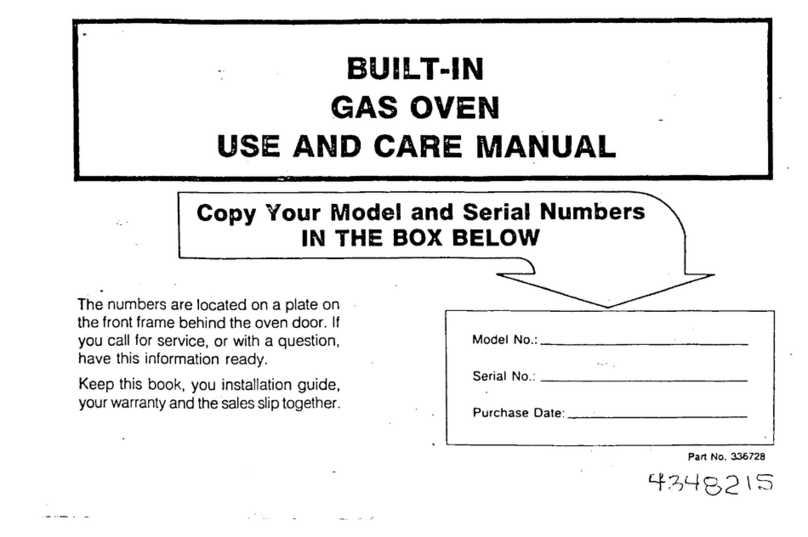
Roper
Roper B4607B0 User manual

Roper
Roper Roper BES450WB1 User manual

Roper
Roper Double Oven User manual
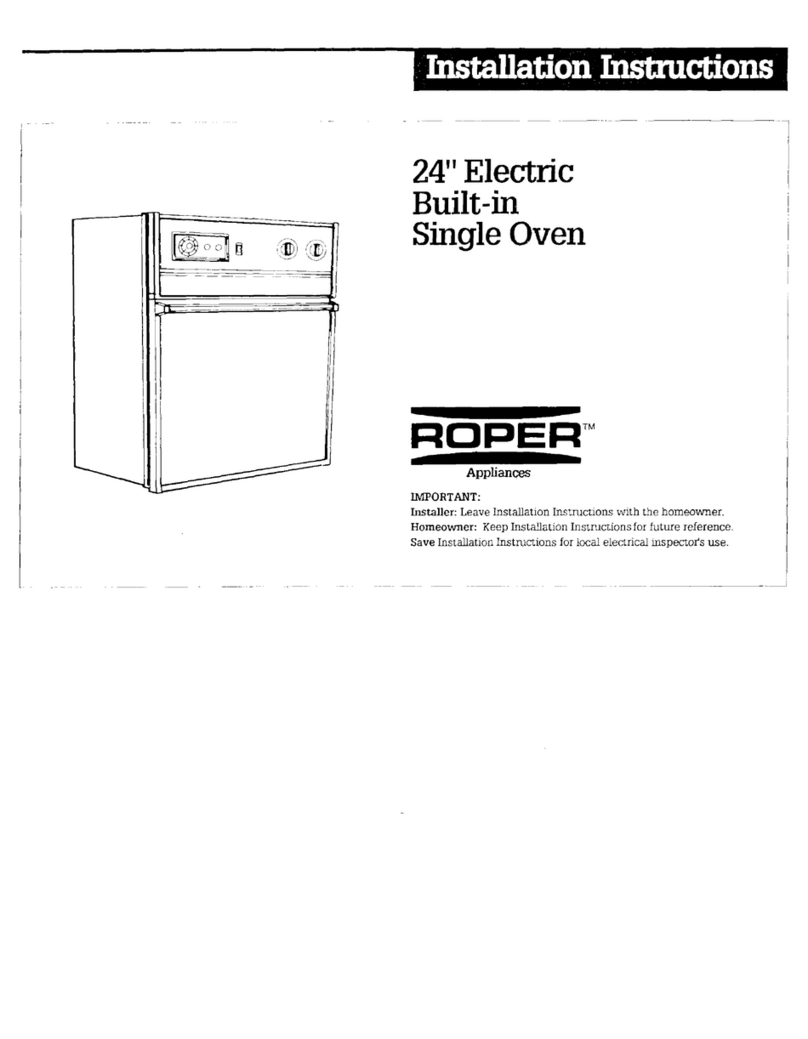
Roper
Roper Convection Oven User manual
